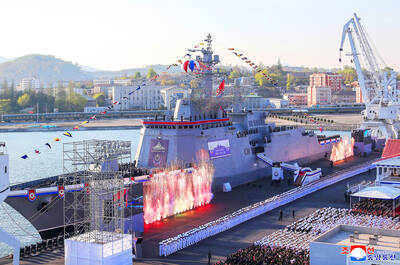For years, US policymakers have watched uneasily as China grew more assertive, fearing that the emerging power would cut into Washington’s clout in one of the world’s most dynamic regions.
However, in recent weeks, China’s rise has instead offered a golden opportunity for the US, which has swiftly rallied behind the growing number of Asian nations that have butted heads with Beijing.
After China piled pressure on Japan to free a captain captured near disputed islands, the US said it considered the chain — known as the Senkaku in Japanese and Diaoyutai (釣魚台) in Chinese — to be under Tokyo’s administration, meaning that US forces would be obliged by treaty to defend Japan in an attack.
With Southeast Asian nations voicing alarm over Chinese attempts to exert sovereignty in disputed waters, US President Barack Obama and regional leaders in a summit on Friday called for freedom of navigation in the South China Sea.
The US also defied Chinese warnings and carried out joint war games with South Korea after accusing Beijing’s ally North Korea of sinking a South Korean vessel.
“It’s always bad when an American lectures someone on arrogance, but the Chinese should beware of premature arrogance,” said Ralph Cossa, president of the Center for Strategic and International Studies’ Pacific Forum.
“The more they flex their muscle in the South China Sea, the more people dial 911 and hope the [US Navy’s] Seventh Fleet will answer. And the same thing with the Japanese,” Cossa said.
In Japan, where a left-leaning government swept to power last year pledging to be more “independent” from the US, Japanese Prime Minister Naoto Kan has thrown his support behind a US base plan and appointed one of his party’s most hawkish figures, Seiji Maehara, as foreign minister in a recent reshuffle.
The US has also built growing partnerships with Southeast Asia, particularly Indonesia and former war foe Vietnam, two countries with historically tense relations with China.
The Obama administration insists it has no grand designs to encircle China. Since taking office, Obama has sought broader relations with China, including cooperation on reviving the global economy and fighting climate change.
However, US Assistant Secretary of State for East Asia Kurt Campbell said he has recently seen a shift in views in the region among those convinced of US decline.
“I see more and more in Asia a recognition that the United States is going to be a dominant, key player in Asia for at least the better part of the next 40 or 50 years,” Campbell said.
Asia has a growing recognition that “yes, China’s role on the global stage has grown much larger in recent years, but the truth is the United States has never left the stage and we’re going to be a main actor on that stage for decades to come,” Campbell said.
The US stations some 100,000 troops in Asia excluding Afghanistan, the vast majority in Japan and South Korea. The US defense budget for the fiscal year beginning in October is US$700 billion, far above China’s US$150 billion budget last year, as estimated by the Pentagon.
US Deputy Secretary of State James Steinberg said the US accepted that China would expand its military, but hoped it would use its forces in a positive way — praising as an example Beijing’s naval deployment to fight piracy off Somalia.
However, a Pentagon study last month found that China’s military had already secured a strong edge over Taiwan, which Beijing claims, and that it was increasingly looking to exert its influence throughout Asia.
Walter Lohman, director of the Asian Studies Center at the conservative Heritage Foundation, said the changing dynamic in Asia has been China’s growing assertiveness, not any shift in US policy.
“The Chinese really believe that we are rallying against them,” Lohman said. “They’re missing a very important point — the Vietnamese are coming to us and the Japanese are coming to us, not the other way around.”

Archeologists in Peru on Thursday said they found the 5,000-year-old remains of a noblewoman at the sacred city of Caral, revealing the important role played by women in the oldest center of civilization in the Americas. “What has been discovered corresponds to a woman who apparently had elevated status, an elite woman,” archeologist David Palomino said. The mummy was found in Aspero, a sacred site within the city of Caral that was a garbage dump for more than 30 years until becoming an archeological site in the 1990s. Palomino said the carefully preserved remains, dating to 3,000BC, contained skin, part of the

TRUMP EFFECT: The win capped one of the most dramatic turnarounds in Canadian political history after the Conservatives had led the Liberals by more than 20 points Canadian Prime Minister Mark Carney yesterday pledged to win US President Donald Trump’s trade war after winning Canada’s election and leading his Liberal Party to another term in power. Following a campaign dominated by Trump’s tariffs and annexation threats, Carney promised to chart “a new path forward” in a world “fundamentally changed” by a US that is newly hostile to free trade. “We are over the shock of the American betrayal, but we should never forget the lessons,” said Carney, who led the central banks of Canada and the UK before entering politics earlier this year. “We will win this trade war and

‘BODIES EVERYWHERE’: The incident occurred at a Filipino festival celebrating an anti-colonial leader, with the driver described as a ‘lone suspect’ known to police Canadian police arrested a man on Saturday after a car plowed into a street party in the western Canadian city of Vancouver, killing a number of people. Authorities said the incident happened shortly after 8pm in Vancouver’s Sunset on Fraser neighborhood as members of the Filipino community gathered to celebrate Lapu Lapu Day. The festival, which commemorates a Filipino anti-colonial leader from the 16th century, falls this year on the weekend before Canada’s election. A 30-year-old local man was arrested at the scene, Vancouver police wrote on X. The driver was a “lone suspect” known to police, a police spokesperson told journalists at the

North Korean leader Kim Jong-un has unveiled a new naval destroyer, claiming it as a significant advancement toward his goal of expanding the operational range and preemptive strike capabilities of his nuclear-armed military, state media said yesterday. North Korea’s state-run Korean Central News Agency (KCNA) said Kim attended the launching ceremony for the 5,000-tonne warship on Friday at the western port of Nampo. Kim framed the arms buildup as a response to perceived threats from the US and its allies in Asia, who have been expanding joint military exercises amid rising tensions over the North’s nuclear program. He added that the acquisition